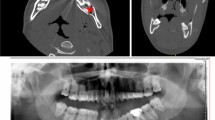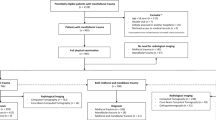Abstract
Objectives
This study aims to determine the factors that influence the quality of radiology reports of maxillofacial computed tomography (CT) scans from patients presenting to the emergency department who sustained mandible fractures. We discuss specific, pertinent details that were either included or excluded from the report that could potentially affect the operating surgeon’s treatment plan.
Methods
A retrospective chart review was completed for a total of 249 patients from 2008 through 2012 who sustained mandibular trauma and underwent multi-detector computed tomography scanning in the emergency department setting. The radiology report was analyzed for each patient for the presence or absence of the following data: degree of fracture displacement, inferior alveolar nerve, foramen or canal involvement, anatomic location of fracture(s), fracture type categorization (simple, compound, comminuted), presence or absence of teeth in line of fracture, and mention of temporomandibular joint.
Results
Radiologists uniformly mention the anatomic location of mandible fractures (247/249, 99 %) and usually make mention of the degree of mandible fracture displacement (176/247, 71 %). The temporomandibular joint is mentioned about half the time (131/249, 52.6 %). Mention of nerve canal involvement in the fracture is most likely when only a maxillofacial CT is ordered (69/105, 65.7 %, p = 0.0433).
Conclusions
More attention should be given to the clinically important characteristics of mandible fractures. A uniform approach for interpreting CT scans and a template for reporting them will improve the overall quality of communication between the radiologist and surgeon.
Similar content being viewed by others
References
Iida S, Kogo M, Sugiura T, Mima T, Matsuya T. Retrospective analysis of 1502 patients with facial fractures. Int J Oral Maxillofac Surg. 2001;30(4):286–90.
Eskitaşcıoğlu T, Ozyazgan I, Coruh A, Günay GK, Yontar Y, Altıparmak M. Fractures of the mandible: a 20-year retrospective analysis of 753 patients. Ulus Travma Acil Cerrahi Derg. 2013;19(4):348–56.
Brasileiro BF, Passeri LA. Epidemiological analysis of maxillofacial fractures in Brazil: a 5-year prospective study. Oral Surg Oral Med Oral Pathol Oral Radiol Endod. 2006;102(1):28–34.
Gassner R, Tuli T, Hächl O, Rudisch A, Ulmer H. Cranio-maxillofacial trauma: a 10-year review of 9,543 cases with 21,067 injuries. J Craniomaxillofac Surg. 2003;31(1):51–61.
Ellis E, Moos KF, El-attar A. Ten years of mandibular fractures: an analysis of 2,137 cases. Oral Surg Oral Med Oral Pathol. 1985;59(2):120–9.
Haug RH, Prather J, Indresano AT. An epidemiologic survey of facial fractures and concomitant injuries. J Oral Maxillofac Surg. 1990;48(9):926–32.
Lo casto A, Priolo GD, Garufi A, et al. Imaging evaluation of facial complex strut fractures. Semin Ultrasound CT MR. 2012;33(5):396–409.
Escott E, Branstetter B. Incidence and characterization of unifocal mandible fractures on CT. Am J Neuroradiol. 2008;29:890–4.
King RE, Scianna JM, Petruzzelli GJ. Mandible fracture patterns: a suburban trauma center experience. Am J Otolaryngol. 2004;25:301–7.
Roth FS, Kokoska MS, Awwad EE, et al. The identification of mandible fractures by helical computed tomography and panorex tomography. J Craniofac Surg. 2005;16(3):394–9.
Ogundare BO, Bonnick A, Bayley N. Pattern of mandibular fractures in an urban major trauma center. J Oral Maxillofac Surg. 2003;61(6):713–8.
Hopper R, Salemy S, Sze R. Diagnosis of midface fractures with CT: what the surgeon needs to know. Radiographics. 2006;26(3):783–93.
Carinci F, Arduin L, Pagliaro F, Zollino I, Brunelli G, Cenzi R. Scoring mandibular fractures: a tool for staging diagnosis, planning treatment, and predicting prognosis. J Trauma. 2009;66(1):215–9.
Shetty V, Atchison K, Belin TR, Wang J. Clinician variability in characterizing mandible fractures. J Oral Maxillofac Surg. 2001;59(3):254–61.
Villarreal PM, Monje F, Junquera LM, Mateo J, Morillo AJ, González C. Mandibular condyle fractures: determinants of treatment and outcome. J Oral Maxillofac Surg. 2004;62(2):155–63.
Shetty V, Atchison K, Der-martirosian C, Wang J, Belin TR. Determinants of surgical decisions about mandible fractures. J Oral Maxillofac Surg. 2003;61(7):808–13.
Conflict of interest
Author Thomas Hagopian, Author James Parelli, Author Lisa Tran, Author Benjamin Abt, and Author Martin Steed declare that they have no conflict of interest.
Human/Animal rights
This article does not contain any studies with human or animal subjects performed by the any of the authors.
Ethical standard
All procedures followed were in accordance with the ethical standards of the responsible committee on human experimentation (institutional and national) and with the Helsinki Declaration of 1964 and later revision. Informed consent was obtained from all patients for being included in the study.
Author information
Authors and Affiliations
Corresponding author
Rights and permissions
About this article
Cite this article
Hagopian, T., Parelli, J., Tran, L. et al. A retrospective analysis of mandibular trauma radiology dictations. Oral Radiol 31, 36–40 (2015). https://doi.org/10.1007/s11282-014-0176-2
Received:
Accepted:
Published:
Issue Date:
DOI: https://doi.org/10.1007/s11282-014-0176-2




